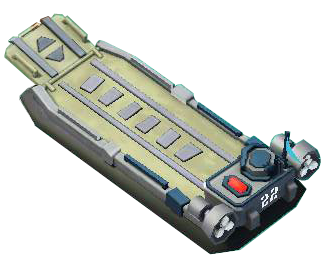

Below them, a plan of the battery indicates the six concrete bunkers that were believed to contain long range guns. These men scaled 30-metre high cliffs to attack a German coastal gun battery that was believed to threaten the Allied fleet. On the edge of the waymarker, men of the US Rangers climb the cliffs at Pointe du Hoc, several miles further west than the main landings at Omaha Beach. In the distance, a destroyer comes close inshore to fire its guns at enemy defences, aiding the American assault troops who were struggling to establish a foothold. Just behind, tanks disembark from a larger craft, an LCT or ‘Landing Craft, Tank’ of the United States Navy. American forces suffered very heavy casualties on this beach, in the face of strong enemy defences. The infantry storm past ‘hedgehog’ obstacles which the Germans had placed on the beaches to sink Allied landing craft. A significant proportion of the troops landing here on D-Day were put ashore by British landing craft. In the centre of the waymarker, an LCA (‘Landing Craft, Assault’) of the Royal Navy delivers American infantry to the beach. The main force landing on Omaha Beach was American, but British forces were in support. At the bottom of the waymarker, a B-17 bomber bearing the USAAF’s ‘star and bars’ insignia, and a Lancaster bomber of the Royal Air Force, flank a view inside the cockpit of one of these heavy bombers. Here as on other beaches, the landings had been preceded by attacks on the German defences by British and other Allied bomber aircraft.

Further inland as they sought to link up with the airborne troops, the Americans encountered thicker vegetation which aided the German defenders. Initially they moved through an area of flooded fields behind the beach, which was only crossed by a few causeways. In the centre of the panel, US infantry are supported by a Sherman tank as they advance inland after landing on Utah Beach. The LSTs at Utah Beach on D-Day were American-manned, but the Royal Navy operated the same ship type on other beaches. These ships could carry dozens of vehicles and had a ramp at the bow for unloading. The adjacent scene shows vehicles disembarking onto the beach from multiple LSTs (Landing Ship, Tank). During the night of 5/6 June the first troops from two US airborne divisions arrived in France by parachute and glider, several miles inland from the beach. British forces did however support operations here, particularly at sea and in the air.Īt the top, three C-47 transport aircraft of the United States Army Air Forces (USAAF) drop American parachutists. Located the furthest west of the five Allied beaches, Utah was one of two American landing areas. They feature scenes representing different aspects of the landings. Designed by sculptor Charles Bergen, the five waymarkers – sculptural signposts located lower down the hillside from the memorial – point to the five D-Day landing beaches.


 0 kommentar(er)
0 kommentar(er)
